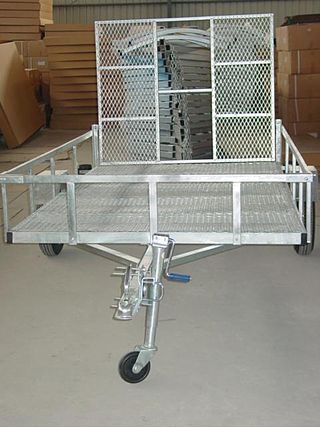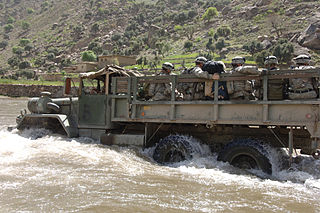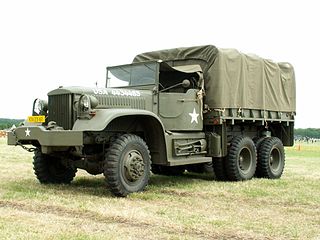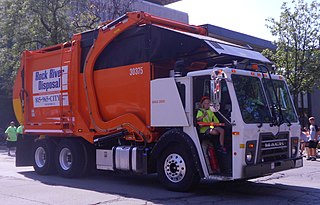
A truck or lorry is a motor vehicle designed to transport freight, carry specialized payloads, or perform other utilitarian work. Trucks vary greatly in size, power, and configuration, but the vast majority feature body-on-frame construction, with a cabin that is independent of the payload portion of the vehicle. Smaller varieties may be mechanically similar to some automobiles. Commercial trucks can be very large and powerful and may be configured to be mounted with specialized equipment, such as in the case of refuse trucks, fire trucks, concrete mixers, and suction excavators. In American English, a commercial vehicle without a trailer or other articulation is formally a "straight truck" while one designed specifically to pull a trailer is not a truck but a "tractor".

A garbage truck is a truck specially designed to collect municipal solid waste and transport it to a solid waste treatment facility, such as a landfill, recycling center or transfer station. In Australia they are commonly called rubbish trucks, or garbage trucks, while in the U.K. dustbin lorry, rubbish lorry or bin lorry is commonly used. Other common names for this type of truck include trash truck in the United States, and refuse truck, dustcart, junk truck, bin wagon or bin van elsewhere. Technical names include waste collection vehicle and refuse collection vehicle (RCV). These trucks are a common sight in most urban areas.

A trailer is an unpowered vehicle towed by a powered vehicle. It is commonly used for the transport of goods and materials.

A dump truck, known also as a dumping truck, dump trailer, dumper trailer, dump lorry or dumper lorry or a dumper for short, is used for transporting materials for construction as well as coal. A typical dump truck is equipped with an open-box bed, which is hinged at the rear and equipped with hydraulic rams to lift the front, allowing the material in the bed to be deposited ("dumped") on the ground behind the truck at the site of delivery. In the UK, Australia, South Africa and India the term applies to off-road construction plants only and the road vehicle is known as a tip lorry, tipper lorry, tipper truck, tip truck, tip trailer or tipper trailer or simply a tipper.

A dumper or dumper truck or dump truck is a truck designed for carrying bulk material, often on building sites. A dumper has a body which tilts or opens at the back for unloading and is usually an open 4-wheeled vehicle with the load skip in front of the driver. The skip can tip to dump the load; this is where the name "dumper" comes from. They are normally diesel powered. A towing eye is fitted for secondary use as a site tractor. Dumpers with rubber tracks are used in special circumstances and provide a more even distribution of weight compared to tires. Continuous tracks allow the operator to carry heavier payload on slick, snowy, or muddy surfaces, and are popular in some countries. Rubber track dumpers offer even weight distribution for transporting heavy payloads over challenging terrains like mud or snow, popular in certain regions. Roll Off Dumpsters, contrastingly, are large, stationary containers designed for substantial waste management, easily loaded and transported by specialized trucks.

The M939 is a 5-ton 6×6 U.S. military heavy truck. The basic cargo versions were designed to transport a 10,000 pounds (4,500 kg) cargo load over all terrain in all weather. Designed in the late 1970s to replace the M39 and M809 series of trucks, it has been in service ever since. The M939 evolved into its own family of cargo trucks, dump trucks, semi-tractors, vans, wreckers, and bare chassis/cabs for specialty bodies. 44,590 in all were produced.

A semi-trailer is a trailer without a front axle. The combination of a semi-trailer and a tractor truck is called a semi-trailer truck.
Hydraulic hooklift hoists are mounted on heavy duty trucks to enable hauliers to change out flatbeds, dumpster bodies, and similar containers. Primarily used in conjunction with tilt frame bodies and specialised roller containers, generally designed for the transportation of materials in the waste, recycling, scrap and demolition industries, as well as for disposal of construction debris.

A flatbed truck is a type of truck the bodywork of which is just an entirely flat, level 'bed' with no sides or roof. This allows for quick and easy loading of goods, and consequently they are used to transport heavy loads that are not delicate or vulnerable to rain, and also for abnormal loads that require more space than is available on a closed body. Flatbed trucks can be either articulated or rigid.

An articulated hauler, articulated dump truck (ADT), or sometimes a dump hauler, is a very large heavy-duty type of dump truck used to transport loads over rough terrain, and occasionally on public roads. The vehicle usually has all-wheel drive and consists of two basic units: the front section, generally called the tractor, and the rear section that contains the dump body, called the hauler or trailer section. Steering is made by pivoting the front in relation to the back by hydraulic rams. This way, all wheels follow the same path, making it an excellent off-road vehicle.

The M39 series 5-ton 6×6 truck (G744) was a family of heavy tactical trucks built for the United States Armed Forces. The basic cargo version was designed to transport a 5-ton (4,500 kg), 14 ft (4.3 m) long load over all terrain in all weather. In on-road service the load weight was doubled.
A specialized set of jargon describe the tools, equipment, and employment sectors used in the trucking industry in the United States. Some terms may be used within other English-speaking countries, or within the freight industry in general. For example, shore power is a term borrowed from shipping terminology, in which electrical power is transferred from shore to ship, instead of the ship relying upon idling its engines. Drawing power from land lines is more efficient than engine idling and eliminates localized air pollution. Another borrowed term is "landing gear", which refers to the legs which support the front end of a semi-trailer when it is not connected to a semi-truck. Some nicknames are obvious wordplay, such as "portable parking lot", in reference to a truck that carries automobiles.
Tyco US-1 Electric Trucking was a slot car line made by Tyco Slot Cars from 1981 to 1985. Its theme was based around road and construction heavy-duty diesel trucks. It was marketed under the tagline of "You Control The Action!"

The Mack MC/MR series, also known as the "Cruise-Hauler", is a cabover truck first introduced in 1978. It is of a distinct "set back front axle" design, with the driver compartment mounted ahead of the front axle and with a large, flat, divided windscreen covering almost half of the truck's frontal aspect.

The M809 Series 5-ton 6x6 truck (G908) was a family of heavy tactical trucks built for the United States Armed Forces. The basic cargo version was designed to transport a 5-ton (4,500 kg), 14 ft (4.3 m) long load over all terrain in all weather. In on-road service the load weight was doubled. Built by AM General, they evolved into the M939 Series.

The Diamond T 4-ton 6×6 truck was a heavy tactical truck built for the United States Army during World War II. Its G-number was G-509. Cargo models were designed to transport a 4-ton (3,600 kg) load over all terrain in all weather. There were also wrecker, dump, and other models. They were replaced by the M39 series 5-ton 6×6 trucks in the 1950s.

The Mack Granite is a series of heavy duty and severe service trucks built by Mack Trucks. It has a long, low-profile hood and a high-visibility cab. Designed as straight trucks for local construction, waste removal, and other vocational jobs, it is also available as a semi-tractor. Introduced in 2001, it remains in production as of today.

The Mack TerraPro is a series of heavy duty and severe service trucks built by Mack Trucks. They are a forward control cab-over-engine type, where the driver sits in front of the axle. A flat front has two large windshields. A spotting feature is small notches in the lower inside of the windshields. It is used in refuse service and for construction concrete pumps.

The Mack LR(Low Ride) is a series of heavy-duty trucks built by Mack Trucks. They are a forward control cab-over-engine type, where the driver sits in front of the axle. A flat front has two large windshields. The cab is very low-profile and has dual driving controls with a stand-up driving position on the right side. It is used in refuse service with front, side, and rear-loading refuse compactor bodies. Introduced in 2015 it remains in production in 2020.





















